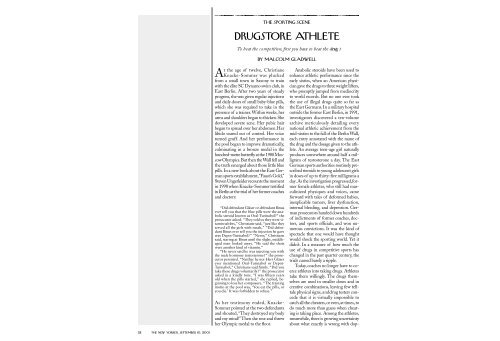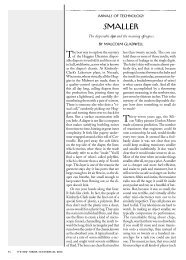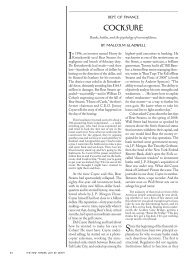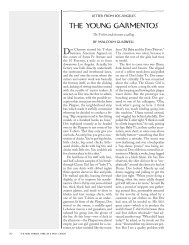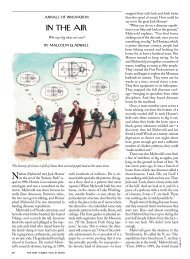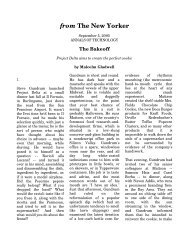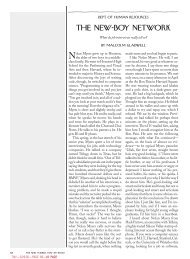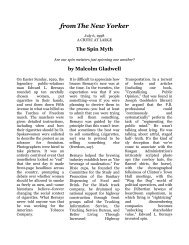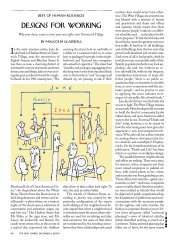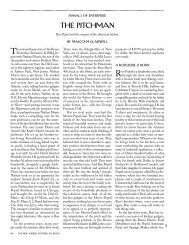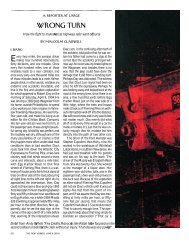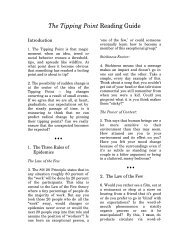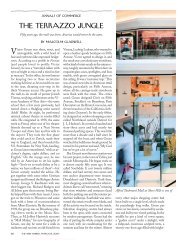DRUGSTORE ATHLETE - Malcolm Gladwell
DRUGSTORE ATHLETE - Malcolm Gladwell
DRUGSTORE ATHLETE - Malcolm Gladwell
You also want an ePaper? Increase the reach of your titles
YUMPU automatically turns print PDFs into web optimized ePapers that Google loves.
5 2 THE NEW YO R K E R, SEPTEMBER 10, 2001<br />
TNY—09/10/01—PAGE 5 2<br />
At the age of tw e lve, C h ri s t i a n e<br />
K n a ck e - Sommer was pluck e d<br />
f rom a small town in Sa xony to tra i n<br />
with the élite SC Dynamo swim cl u b, i n<br />
East Berl i n . A fter two years of s t e a d y<br />
p ro g re s s ,she was given regular injection s<br />
and daily doses of s m a ll baby-blue pill s ,<br />
w h i ch she was re q u i red to take in the<br />
p resence of a tra i n e r.Within weeks, h e r<br />
a rms and shoulders began to thick e n .Sh e<br />
d eveloped seve re acne. Her pubic hair<br />
began to spread over her abdom e n .H e r<br />
libido soared out of c on t ro l .Her voice<br />
t u rned gru f f. And her perf o rmance in<br />
t h epool began to improve dra m a t i ca ly,<br />
culminating in a bron ze medal in the<br />
h u n d re d - m e t butterfly r at the 1980 Mosc<br />
ow Olym p i c s .But then the Wa ll fe ll and<br />
the truth emerged about those little blue<br />
p i ll s .In a new book about the East G e rman<br />
sports establishment,“Fa u s t’s Gold,”<br />
St even Ungerleider recounts the mom e n t<br />
in 1998 when Knack e - Sommer testifie d<br />
in Berlin at the trial of her former coach e s<br />
and doctors:<br />
“Did defendant Gläser or defendant Binus<br />
ever tell you that the blue pills were the anabolic<br />
steroid known as Oral-Turinabol?” the<br />
p rosecutor asked. “They told us they were vitamin<br />
tablets,” Christiane said, “just like they<br />
s e rved all the girls with meals.” “Did defendant<br />
Binus ever tell you the injection he gave<br />
was Depot-Turinabol?” “Never,” Christiane<br />
said, staring at Binus until the slight, middleaged<br />
man looked away. “He said the shots<br />
w e re another kind of vitamin.”<br />
“He never said he was injecting you with<br />
the male hormone testosterone?” the pro s ecutor<br />
persisted. “Neither he nor Herr Gläser<br />
ever mentioned Oral-Turinabol or Depot-<br />
Turinabol,” Christiane said firm l y. “Did you<br />
take these drugs voluntarily?” the pro s e c u t o r<br />
asked in a kindly tone. “I was fifteen years<br />
old when the pills started,” she replied, beginning<br />
to lose her composure. “The training<br />
motto at the pool was, ‘You eat the pills, or<br />
you die.’ It was forbidden to re f u s e . ”<br />
As her testimony ended, K n a ck e -<br />
Sommer pointed at the two defe n d a n t s<br />
and shouted,“T h ey destroyed my body<br />
and my mind!”Then she rose and threw<br />
her Olympic medal to the flo o r.<br />
THE SPORTING SCENE<br />
<strong>DRUGSTORE</strong> <strong>ATHLETE</strong><br />
To beat the competition, first you have to beat the drug e s t . t<br />
BY MALCOLM GLADWELL<br />
Anabolic steroids have been used to<br />
enhance athletic perf o rmance since the<br />
e a rly sixties, when an Am e ri can phys ician<br />
gave the drugs to three weight lift e r s ,<br />
who prom p t ly jumped from mediocri ty<br />
to world re c o rd s .But no one ever took<br />
the use of i llegal drugs quite so far as<br />
the East Germ a n s .In a military hospital<br />
outside the former East Berl i n ,in 1991,<br />
i nvestigators discove red a ten-volume<br />
a rch i ve meticulously detailing eve ry<br />
n a t i onal athletic ach i evement from the<br />
mid-sixties to the fall of t h eB e rlin Wa ll ,<br />
e a ch entry annotated with the name of<br />
the drug and the dosage given to the athl<br />
e t e .An ave rage teen-age girl natura lly<br />
p roduces som ew h e re around half a mill<br />
i g ram of t e s t o s t e rone a day. The East<br />
G e rman sports authorities ro u t i n e ly pres<br />
c ribed steroids to young adolescent girl s<br />
i n doses of up to thirty - five mill i g rams a<br />
d ay.As the inve s t i g a t i on pro g re s s e d ,f o rmer<br />
female athletes, who still had masc<br />
u l i n i zed physiques and voices, ca m e<br />
f o rw a rd with tales of d e f o rmed babies,<br />
i n e x p l i cable tumors, l i ver dys f u n c t i on ,<br />
i n t e rnal bleeding, and depre s s i on .G e rman<br />
prosecutors handed down hundre d s<br />
o f indictments of f o rmer coach e s ,d o ct<br />
o r s , and sports offic i a l s ,and w on num<br />
e rous conv i c t i on s .It was the kind of<br />
s p e c t a cle that one would have thought<br />
would shock the sporting worl d . Yet it<br />
d i d n’t . In a measure of h ow mu ch the<br />
use of d rugs in com p e t i t i ve sports has<br />
changed in the past quarter century, t h e<br />
t rials caused bare ly a ri p p l e .<br />
To d ay, c o a ches no longer have to coe<br />
rce athletes into taking dru g s .At h l e t e s<br />
take them will i n g ly. The drugs thems<br />
e lves are used in smaller doses and in<br />
c re a t i ve com b i n a t i on s ,leaving few telltale<br />
phys i cal signs, a n dd rug testers c oncede<br />
that it is virt u a lly impossible to<br />
ca t ch all the ch e a t e r s ,or eve n ,at times, t o<br />
do mu ch more than guess when ch e a ting<br />
is taking place. Am ong the athletes,<br />
m e a nw h i l e, t h e re is growing uncert a i n ty<br />
about what exactly is wrong with dop-
i n g. When the cyclist Lance Arm s t ron g<br />
a s s e rted last ye a r, a fter his second cons<br />
e c u t i ve Tour de France victory, that<br />
he was dru g - f re e, s ome doubters wond<br />
e red whether he was lyi n g, and others<br />
s i m p ly assumed he was, and won d e re d<br />
w hy he had to.The moral cl a ri ty of t h e<br />
East German scandal—with its coerc<br />
i ve coach e s ,damaged athletes,and cor-<br />
rupted com p e t i t i ons—has given way to<br />
shades of g ray. In today’s cl i m a t e, t h e<br />
most telling moment of the East German<br />
scandal was not Knack e - Som m e r’s<br />
o u tb u r s t .It was when one of the syst<br />
e m’s former top offic i a l s ,at the beginning<br />
of his tri a l , s h rugged and quoted<br />
B re ch t :“ C om p e t i t i e vsport<br />
begins where<br />
h e a l t hy sport ends.”<br />
Pe rhaps the best example of h ow<br />
mu rky the drug issue has become is<br />
the case of Ben Joh n s on ,the Canadian<br />
s p rinter who won the one hundred met<br />
res at the Seoul Olym p i c s , in 1988.<br />
J oh n s on set a new world re c o rd ,t h e n<br />
failed a post-race drug test and was<br />
p rom p t ly stripped of his gold medal a n d<br />
suspended from intern a t i onal com p e t i-<br />
t i on .No athlete of J oh n s on’s ca l i b re has<br />
ever been exposed so dra m a t i ca ly, b u t<br />
his disgrace was not quite the victory for<br />
clean com p e t i t i on that it appeared to be.<br />
J oh n s on was part of a group of w o rl d -<br />
class sprinters based in To ronto in the<br />
n i n e t e e n - s eventies and eighties and<br />
t rained by a bri lliant coach named Charlie<br />
Fra n c i s.Francis was dri ven and ambi-<br />
“Only ca reless and stupid people ever get caught in drug e s t s t,<br />
”one steroid ex p ert says.<br />
TNY—09/10/01—PAGE 5 3—133SC.—LIVE OPI ART—R 10308—133SC,—MATCHPRINT TO ARRIVE ON FRIDAY A.M. POUCH!!!<br />
t i o u s ,eager to give his athletes the same<br />
o p p o rtunities as their competitors from<br />
the United States and Eastern Euro p e,<br />
and in 1979 he began discussing stero i d s<br />
with one of his pri ze spri n t e r s ,An g e ll a<br />
Tayl o r. Francis felt that Taylor had the<br />
potential that year to run the two hund<br />
red metres in close to 22.90 secon d s ,a<br />
time that would put her within stri k i n g<br />
distance of the two best sprinters in the<br />
w o rl d , E ve lyn Ashford , o f the United<br />
St a t e s ,and Marita Koch , o f East Germ<br />
a ny. B u t , s e e m i n g ly out of n ow h e re,<br />
A s h f o rd suddenly improved her tw o -<br />
h u n d re d - m e t e rtime<br />
by six-tenths of a<br />
s e c on d . Then Koch ran what Fra n c i s<br />
ca ll s ,in his autobiogra phy,“ Speed Tra p, ”<br />
a “science fic t i on a l” 2 1 . 7 1 .In the spri n t s ,<br />
individual improvements are usually<br />
m e a s u red in hundredths of a secon d ;<br />
a t h l e t e s ,once they have re a ched their<br />
e a rly tw e n t i e s , typ i ca lly improve their<br />
p e rf o rmance in small ,steady incre m e n t s ,<br />
as experience and strength incre a s e .B u t<br />
these were quantum leaps,and to Fra n c i s<br />
the explanation was obv i o u s . “An g e ll a<br />
w a s n’t losing ground because of a talent<br />
g a p, ”he wri t e s ;“she was losing because of<br />
a drug gap, and it was widening by the<br />
d ay. ”(In the case of K o ch ,at least, he was<br />
ri g h t .In the East German arch i ve s ,i nvestigators<br />
found a letter from Koch to<br />
the director of re s e a rch at V. E . B . J e-<br />
n a ph a rm ,an East German ph a rm a c e u t -i<br />
cal house, in which she com p l a i n e d ,“M y<br />
d rugs were not as potent as the ones that<br />
w e re given to my opponent Bärbel Ecke<br />
rt ,who kept beating me.” In East Germ<br />
a ny, U n g e rleider wri t e s ,this part i c u l a r<br />
c omplaint was known as “d o p e - e nv y. ” )<br />
La t e r, Francis says ,he was con f ronted at<br />
a tra ck meet by Brian Ol d fie l d ,then on e<br />
o f the worl d’s best shot-putters:<br />
“When are you going to start getting serious?”<br />
he demanded. “When are you going to<br />
tell your guys the facts of life?” I asked him<br />
how he could tell they were n ’t already using<br />
s t e roids. He replied that the muscle density<br />
just wasn’t there. “Your guys will never be<br />
able to compete against the Americans—their<br />
c a reers will be over,” he persisted.<br />
Am ong worl d - class athletes, the lure<br />
o f s t e roids is not that they magica lly<br />
t ra n s f o rm perf o rm a n c e—no drug ca n<br />
do that—but that they make it possible<br />
to train hard e r. An aging baseball star,f o r<br />
i n s t a n c e, m ay re a l i ze that what he needs<br />
to hit a lot more home runs is to double<br />
the intensity of his weight tra i n i n g. O rd<br />
i n a ri ly,this might actually hurt his perf<br />
o rm a n c e .“When yo u’re under that kind<br />
o f phys i cal stre s s , ” C h a rles Ye s a l i s ,a n<br />
epidemiologist at Pe n n s ylvania St a t e<br />
U n i ve r s i ty, s ays ,“ your body releases cort<br />
i c o s t e ro i d s ,and when your body start s<br />
making those horm ones at inappro p ri a t e<br />
times it blocks testosteron e .And instead<br />
o f being anabolic—instead of b u i l d i n g<br />
mu s cl e— c o rt i c o s t e roids are ca t a b o l i c .<br />
T h ey break down mu s cl e .T h a t’s cl e a rly<br />
s omething an athlete doesn’t want.”Ta king<br />
steroids counteracts the impact<br />
o f c o rt i c o s t e roids and helps the body<br />
bounce back f a s t e r. I f that hom e - ru n<br />
hitter was taking testosterone or an anabolic<br />
stero i d ,h e’d have a better chance of<br />
h a n dling the extra weight tra i n i n g.<br />
It was this extra training that Fra n c i s<br />
THE NEW YO R K E R, SEPTEMBER 10, 2001 5 3
and his sprinters felt they needed to re a ch<br />
the top. An g e lla Taylor was the first<br />
to start taking stero i d s .Ben Joh n s on foll<br />
owed in 1981,when he was tw e n ty ye a r s<br />
o l d ,beginning with a daily dose of five<br />
m i ll i g rams of the steroid Dianabol, i n<br />
t h ree-week on - a n d - o f f cycl e s . Ove r<br />
t i m e, that protocol grew more com p l e x .<br />
In 1984, Taylor visited a Los An g e l e s<br />
d o c t o r,R o b e rt Kerr,who was famous for<br />
his willingness to provide athletes with<br />
ph a rm a c o l o g i cal assistance. He suggested<br />
that the Canadians use human<br />
g rowth horm on e, the pituitary e x t ra c t<br />
that promotes lean mu s cle and that h a d<br />
b e c om e, in Fra n c i s ’s word s ,“the rage in<br />
elite tra ck circl e s . ” Kerr also re c ommended<br />
three additional substances, a ll<br />
o f w h i ch were believed to promote the<br />
b o d y’s pro d u c t i on of g rowth horm on e :<br />
the amino acids arginine and orn i t h i n e<br />
and the dopamine precursor L-dopa. “I<br />
would later learn , ” Francis wri t e s ,“ t h a t<br />
one group of Am e ri can women was using<br />
t h ree times as mu ch growth horm one as<br />
Kerr had suggested,in addition to 15 mill<br />
i g rams per day of D i a n a b o l ,another 15<br />
m i ll i g rams of An a v a r, large amounts of<br />
t e s t o s t e ron e,and thyrox i n e,the syn t h e t i c<br />
t hyroid horm one used by athletes to speed<br />
the metabolism and keep people lean.”<br />
But the Canadians stuck to their initial<br />
re g i m e n ,making on ly a few ch a n g e s:Vitamin<br />
B 1 2,a non - s t e roidal mu s cle builder<br />
ca lled inosine, and occa s i onal shots of<br />
t e s t o s t e rone were added; Dianabol was<br />
d ropped in favor of a newer steroid ca ll e d<br />
Fu ra za b o l ;and L-dopa, w h i ch turn e d<br />
out to cause stiffness, was replaced with<br />
the blood-pre s s u re drug Dixari t .<br />
Going into the Seoul Olym p i c s ,t h e n ,<br />
J oh n s on was a walking ph a rm a cy.B u t —<br />
and this is the great irony of his ca s e—<br />
n one of the drugs that were part of h i s<br />
f o rmal ph a rm a c e u t i cal protocol re s u l t e d<br />
in his failed drug test. He had alre a d y<br />
reaped the benefit of the steroids in intense<br />
workouts leading up to the games,<br />
and had stopped Fu ra zabol and testost<br />
e rone long enough in advance that all<br />
t races of both supplements should have<br />
d i s a p p e a red from his system by the time<br />
o f his ra c e—a process he sped up by taking<br />
the d i u retic Modure t.Human growt h<br />
h o rm one wasn’t—and still isn’t — d etectable<br />
by a drug test, and arginine, o rn<br />
i t h i n e, and Dixarit were legal. J oh n s on<br />
should have been cl e a n .The most stri king<br />
(and unintention a lly hilarious) mo-<br />
5 4 THE NEW YO R K E R, SEPTEMBER 10, 2001<br />
TNY—09/10/01—PAGE 5 4—LIVE ART #22919—PLEASE INSPECT AND REPORT ON QUALITY.<br />
ment in “ Speed Tra p”c omes when Fra ncis<br />
describes his bew i l d e rment at being<br />
i n f o rmed that his star runner had failed<br />
a drug test—for the anabolic stero i d<br />
s t a n o zo l o l “I . was flo o re d , ”Francis wri t e s :<br />
To my knowledge, Ben had never injected<br />
stanozolol. He occasionally used Wi n s t rol, an<br />
oral version of the drug, but for no more than<br />
a few days at a time, since it tended to make<br />
him stiff. He’d always discontinued the tablets<br />
at least six weeks before a meet, well beyond<br />
the accepted “clearance time.” . . . After seven<br />
years of using steroids, Ben knew what he<br />
was doing. It was inconceivable to me that he<br />
might take stanozolol on his own and jeopardize<br />
the most important race of his life.<br />
Francis suggests that Joh n s on’s uri n e<br />
sample might have been delibera t e ly<br />
c ontaminated by a ri v a l ,a charge that is<br />
less pre p o s t e rous than it sounds. D o c uments<br />
from the East German arch i ve<br />
s h ow, for example, that in intern a t i on a l<br />
c om p e t i t i ons securi ty was so lax that<br />
u ri n esamples were sometimes switch e d ,<br />
stolen from a “cl e a n” a t h l e t e, or simply<br />
“b o r row e d”f rom a non c om p e t i t o .“T r h e<br />
p u re u rine would either be infused by a<br />
ca t h e t e rinto the com p e t i t o r’s bladder (a<br />
rather painful pro c e d u re) or be held in<br />
c on d oms until it was time to give a specimen<br />
to the drug con t rol lab, ”U n g e rl e ider<br />
wri t e s .(The top East German sport s<br />
o f ficial Manfred Höppner was once in<br />
charge of u rine samples at an intern at<br />
i onal weight-lifting com p e t i t i on .Wh e n<br />
he re a l i zed that seve ral of his weight<br />
l i fters would not pass the test, he brok e<br />
open the seal of their specimens,p o u re d<br />
out the con t e n t s ,a n d ,U n g e rleider notes,<br />
“ t o ok a nice long leak of p u re urine into<br />
them.”) It is also possible that Joh n s on’s<br />
test was simply botch e d .Two years later,<br />
in 1990,t ra ck and fie l d’s gove rning body<br />
claimed that Butch Reyn o l d s ,the worl d’s<br />
f o u r - h u nd re d - m e t re re c o rd holder, h a d<br />
tested posi t i ve for the steroid nandrol<br />
on e,and suspended him for two ye a r s .I t<br />
did so despite the fact that half o f h i s<br />
u rine-sample data had been misplaced,<br />
that the testing equipment had failed<br />
d u ring analysis of the other half o f h i s<br />
s a m p l e, and that the lab technician who<br />
did the test identified Sample H6 as pos-<br />
i t i ve—and Reyn o l d s ’s sample was numb<br />
e red H5. R eynolds lost the prime ye a r s<br />
o f his ca re e r.<br />
We may never know what re a ly happened<br />
with Joh n s on’s assay,and perhaps it<br />
d o e s n’t mu ch matter.He w a sa doper.B u t<br />
cl e a rly this was something less than a vict<br />
o ry for drug enforc e m e n t .H e re was a<br />
man using human growth horm on e,<br />
D i x a ri t ,i n o s i n e, t e s t o s t e ron e, and Fu raza<br />
b o l , and the on ly substance that the<br />
testers could find in him was stanozo l o l —<br />
w h i ch may have been the on ly illegal dru g<br />
that he h ad n’t u s e d .Nor is it encoura g i n g<br />
that Joh n s on was the on ly prominent athlete<br />
caught for drug use in Se o u l .It is hard<br />
to believe, for instance, that the spri n t e r<br />
Fl o rence Gri f fith Joyn e r, the star of t h e<br />
Seoul games, was cl e a n .B e f o re 1988,h e r<br />
best times in the hundred metres and the<br />
two hundred metres were, re s p e c t i ve ly,<br />
10.96 and 21.96. In 1988, a suddenly<br />
huskier FloJo ran 10.49 and 21.34, t i m e s<br />
that no runner since has even come cl o s e<br />
to equall i n g. In other word s ,at the age of<br />
tw e n ty-eight—when most athletes are<br />
beginning their decl i n e— G ri f fith Joyn e r<br />
t ra n s f o rmed herself in one season from a<br />
ca re e r - l ong better-than-ave rage spri n t e r<br />
t othe fastest female sprinter in history.O f<br />
c o u r s e, FloJo never failed a drug test. B u t<br />
what does that prove? FloJo went on to<br />
make a fortune as a corp o rate spok e sw<br />
om a n .J oh n s on’s suspension cost him an<br />
estimated tw e n ty - five mill i on dollars in<br />
lost endorsements. The real lesson of t h e<br />
Seoul Olympics may simply have been<br />
that Joh n s on was a ve ry unlucky man.<br />
The basic problem with drug testing is<br />
that testers are alw ays one step b ehind<br />
athletes. It can take years for sport s<br />
a u t h o rities to fig u re out what drugs athletes<br />
are using, and even longer to dev i s e<br />
e f fe c t i ve means of detecting them. An abolic<br />
steroids were n’t banned by the Intern<br />
a t i onal Olympic Committee until 1975,<br />
almost a decade after the East Germ a n s<br />
s t a rted using them.In 1996,at the At l a n t a<br />
Olym p i c s , five athletes tested positive<br />
for what we now know to be the dru g<br />
B rom a n t a n ,but they were n’t suspended,<br />
b e cause no one knew at the time what<br />
Bromantan was. (It turned out to be a<br />
Russian-made psych o - s t i mulant.) H u m a n<br />
g rowth horm on e, m e a nw h i l e, has b e e n<br />
a round for tw e n ty ye a r s ,and testers still<br />
h a ve n’t fig u red out how to detect it.<br />
Pe rhaps the best example of the diffi-
culties of d rug testing is testosteron e .I t<br />
has been used by athletes to enhance<br />
p e rf o rmance since the fift i e s ,and the Int<br />
e rn a t i onal Olympic Committee announced<br />
that it would cra ck down on<br />
t e s t o s t e rone supplements in the early<br />
n i n e t e e n - e i g h t i e This s . didn’t mean that<br />
the I.O. C . was going to test for testost<br />
e rone dire c t ly, t h o u g h , b e cause the<br />
t e s t o s t e rone that athletes were getting<br />
f rom a needle or a pill was largely indistinguishable<br />
from the testosterone they<br />
p roduce natura lly. What was pro p o s e d ,<br />
i n s t e a d , was to com p a re the level of<br />
t e s t o s t e rone in urine with the level of a nother<br />
horm on e, e p i t e s t o s t e on r e, to det<br />
e rmine what’s ca lled the T/E ra t i o. Fo r<br />
most people, under normal circ u ms<br />
t a n c e s ,that ratio is 1:1,and so the theory<br />
was that if testers found a lot more testost<br />
e rone than epitestosterone it would be a<br />
sign that the athlete was ch e a t i n g. Si n c e<br />
a small number of people have natura lly<br />
high levels of t e s t o s t e ron e, the I.O. C .<br />
avoided the risk of f a l s e ly accusing anyone<br />
by setting the legal limit at 6:1.<br />
Did this stop testosterone use? Not at<br />
a ll . T h rough mu ch of the eighties and<br />
n i n e t i e s ,most sports organiza t i ons conducted<br />
their drug testing on ly at major<br />
c om p e t i t i on s .Athletes taking testosterone<br />
would simply do what Joh n s on did,<br />
and taper off their use in the days or<br />
weeks prior to those eve n t s .So sports aut<br />
h o rities began ra n d om ly showing up at<br />
a t h l e t e s ’houses or training sites and demanding<br />
urine samples. To this, d o p e r s<br />
re s p onded by taking extra doses of e p it<br />
e s t o s t e rone with their testosteron e, s o<br />
their T/E would remain in balance.Te s te<br />
r s ,in turn , began t reating elevated epit<br />
e s t o s t e rone levels as suspicious, t o o. B u t<br />
• •<br />
that still left athletes with the claim that smoothing over the old, i n c ri m i n a t i n g the test for that peri o d ,you can pro b a b ly<br />
t h ey were among the few with natura lly s p i k e s .The patch has another advan- pass the test. And if you don’t want to<br />
e l evated testosteron e .Te s t e r s ,t h e n ,w e re t a g e :once you take it off, your testos- take that ch a n c e, you can just keep yo u r<br />
f o rced to take multiple urine samples, t e rone level will drop ra p i dly, re t u rn i n g t e s t o s t e rone below 6:1,w h i ch ,by the way,<br />
m e a s u ring an athlete’s T/E ratio over sev- to norm a l ,depending on the dose and s t i ll provides a whopping perf o rm a n c e<br />
eral weeks. Som e one with a natura lly e l- the person ,in as little as an hour.“I t’s the b e n e fit .“The bottom line is that on ly<br />
evated T/E ratio will have fairly con s i s- peaks that get you ca u g h t , ” s ays Don ca reless and stupid people ever get ca u g h t<br />
t e nt ratios from week to week. Som e on e C a t l i n ,who runs the U.C.L.A.Olym p i c in drug tests,” C h a rles Yesalis says .“T h e<br />
who is doping will have telltale spikes— An a lyt i cal La b o ra t o ry.“I f you took a pill élite athletes can hire top medical and<br />
times immediately after taking shots this morning and an unannounced test s c i e n t i fic people to make sure nothing<br />
or pills when the level of the horm one c omes this aft e rn o on ,yo u’d better have a bad happens, and you ca n’t ca t ch them.”<br />
in his blood soars. Did all these pre ca ut<br />
i ons mean that cheating stopped? O f<br />
course not. Athletes have now switch e d<br />
bottle of e p i t e s t o s t e rone handy. B u t , i f<br />
you are on the patch and you know yo u r<br />
own ph a rm a c ok i n e t i c s ,a l you l have to do<br />
But here is where the doping issue<br />
s t a rts to get com p l i ca t e d for , there’s a<br />
f rom injection to tra n s d e rmal testoster- is pull it off. ”In other word s ,i f you know case to be made that what looks like failone<br />
patch e s , w h i ch administer a con- h ow long it takes for you to get back u rere a ly isn’t—that regulating aggre s s i ve<br />
t i nuous low - l evel dose of the horm on e, under the legal limit and successfully stall d o p i n g, the way the 6:1 standard does, i s<br />
TNY—09/10/01—PAGE 5 5—LIVE OPI ART #A6723—133SC.<br />
THE NEW YO R K E R, SEPTEMBER 10, 2001 5 5
a better idea than trying to prohibit dru g<br />
u s e .Take the example of e ryt h ro p o i e t i n ,<br />
or EP O. EP O is a horm one released by<br />
your kidneys that stimulates the pro d u ct<br />
i on of red blood cell s ,the body’s ox y g e n<br />
ca r ri e r s .A man-made ve r s i on of the hor-<br />
m one is given to those with suppre s s e d<br />
re d - b l o o d - c e l lcounts,<br />
like patients und<br />
e r going kidney dialysis or ch e m o t h e ra<br />
p y. But over the past decade it has also<br />
b e c ome the drug of choice for endura n c e<br />
a t h l e t e s ,b e cause its ability to increase the<br />
amount of oxygen that the blood ca n<br />
ca r ry to the mu s cles has the effect of<br />
p o s tp oning fatigue. “The studies that<br />
h a ve attempted to estimate EP O ’s imp<br />
o rtance say it’s worth about a thre e - ,<br />
f o u r - ,or five-per-cent advantage, w h i ch<br />
is huge, ” Catlin says . EPO also has the<br />
advantage of being a copy of a natura lly<br />
o c c u r ring substance, so it’s ve ry hard to<br />
t e ll if s om e one has been injecting it. ( A<br />
cynic would say that this had som e t h i n g<br />
to do with the spate of re m a rkable times<br />
in e n d u rance races during that peri o d . )<br />
So how should we test for EPO? One<br />
a p p ro a ch , w h i ch was used in the late<br />
nineties by the Intern a t i onal Cycl i n g<br />
U n i on ,is a test mu ch like the T/E ra t i o<br />
for testosteron e .The percentage of yo u r<br />
total blood volume which is taken up by<br />
red blood cells is known as your hemato<br />
c ri t . The ave rage adult male has a<br />
h e m a t o c rit of b e tween thirty-eight and<br />
f o rty-four per cent. Since 1995, the cycling<br />
authorities have decl a red that any<br />
TNY—09/10/01—PAGE 5 8—LIVE OPI ART #A4566—133 LS.<br />
rider who had a hematocrit above fifty<br />
per cent would be suspended—a delibe<br />
ra t e ly generous standard (like the T / E<br />
ratio) meant to avoid falsely accusing<br />
s om e one with a natura lly high hemato<br />
c ri t .The hematocrit rule also had the<br />
b e n e fit of p rotecting athletes’ h e a l t h .I f<br />
you take too mu ch EP O, the pro f u s i on<br />
o f red blood cells makes the blood sluggish<br />
and heavy, placing enormous stre s s<br />
on the heart .In the late eighties, at least<br />
fifteen pro fe s s i onal cyclists died from<br />
suspected EPO ove rd o s e s .A fifty - p e r -<br />
cent hematocrit limit is below the point<br />
at which EPO becomes dangero u s .<br />
B u t ,like the T/E standard ,the hemat<br />
o c rit standard had a perverse effe c t : i t<br />
set the legal limit so high that it actually<br />
e n c o u raged cyclists to titrate their dru g<br />
use up to the legal limit. A fter all ,if yo u<br />
a re riding for three weeks through the<br />
mountains of France and Sp a i n ,t h e re’s a<br />
big diffe rence between a hematocrit of<br />
f o rty-four per cent and one of 49.9 per<br />
c e n t . This is why Lance Arm s t ron g<br />
faced so many hostile questions about<br />
EPO from the European pre s s — a n d<br />
w hy eye b rows were raised at his five -<br />
year re l a t i onship with an Italian doctor<br />
who was thought to be an expert on<br />
p e rf o rmance-enhancing dru g s.I f A rms<br />
t rong had, s ay, a hematocrit of f o rty -<br />
four per cent, the thinking went, w hy<br />
w o u l d n’t he have raised it to 49.9, p a rt i cu<br />
l a rly since the rules (at least, in 2000)<br />
i m p l i c i t ly all owed him to do so. An d ,<br />
“My guess is our tax reb a te has arrive d. ”<br />
i f he didn’t , h ow on earth did he win?<br />
The problems with hematocrit testing<br />
h a ve inspired a second stra t e gy, w h i ch<br />
was used on a limited basis at the Syd n ey<br />
Olympics and this summer’s Wo rl d<br />
Tra ck and Field Champion s h i p s .T h i s<br />
test measures a number of phys i o l o g i ca l<br />
m a rkers of EPO use,i n cluding the pre sence<br />
of re t i c u l o cyt e s ,w h i ch are the imm<br />
a t u re red blood cells produced in large<br />
numbers by EPO injection s .I f you have<br />
a lot more re t i c u l o cytes than norm a l ,<br />
then there’s a good chance yo u’ve used<br />
EPO re c e n t ly. The blood work is foll<br />
owed by a con firm a t o ry uri n a lys i s .T h e<br />
test has its weaknesses. I t’s re a lly on ly<br />
useful in picking up EPO used in the<br />
p revious week or so,w h e reas the benefit s<br />
o f taking the substance persist for a<br />
m on t h .But there’s no question that, i f<br />
ra n d om EPO testing were done aggre ss<br />
i ve ly in the weeks leading to a major<br />
c om p e t i t i on ,it would substantially reduce<br />
ch e a t i n g.<br />
On paper, this second stra t e gy sounds<br />
like a better sys t e m .But there’s a perverse<br />
effect here as well . By discoura g -<br />
ing EPO use, the test is simply pushing<br />
s a vvy athletes tow a rd s ynthetic compounds<br />
ca lled hemoglobin-based ox y g e n<br />
ca r ri e r s ,w h i ch serve mu ch the same purpose<br />
as EPO but for which there is no<br />
test at the mom e n t .“I re c e n t ly read off a<br />
list of these new blood-oxygen expanders<br />
to a group of t ox i c o l o g i s t s ,and none<br />
had heard of a ny of t h e m , ”Yesalis says .<br />
“T h a t’s how fast things are mov i n g. ”T h e<br />
attempt to prevent EPO use a c t u a lly promotes<br />
inequity:it gives an enormous advantage<br />
to those athletes with the means<br />
to keep up with the next wave of ph a rm<br />
a c o l o gy. By con t ra s t ,the hematocri t<br />
l i m i t ,though more perm i s s i ve, c reates a<br />
kind of ph a rm a c e u t i cal pari ty.The same<br />
is true of the T/E limit. At the 1986<br />
w o rld swimming ch a m p i on s h i p s , t h e<br />
East German Kristin Otto set a worl d<br />
re c o rd in the hundre d - m e t re fre e s tyl e,<br />
with an extra o rd i n a ry display of p ower in<br />
the final leg of the ra c e . Ac c o rding to<br />
East German re c o rd s ,on the day of h e r<br />
race Otto had a T/E ratio of 1 8 : 1 .Te s ting<br />
can prevent that kind of a g g re s s i ve<br />
d o p i n g ;it can insure no one goes above<br />
6 : 1 .That is a less than perfect outcom e,<br />
o f c o u r s e, but intern a t i onal sports is<br />
not a perfect worl d . It is a place where<br />
Ben Joh n s on is disgraced and FloJo ru n s<br />
f re e, w h e re Butch Reynolds is barred for
two years and East German coaches pee<br />
into cups—and where athletes without<br />
access to the cutting edge of m e d i c i n e<br />
a re condemned to second place. Si n c e<br />
d rug testers cannot protect the puri ty of<br />
s p o rt , the ve ry least they can do is to<br />
make sure that no athlete can cheat more<br />
than any other.<br />
The first man to break the fourminute<br />
mile was the Englishman<br />
Roger Bannister, on a windswept cinder<br />
t ra ck at Ox f o rd, n e a rly fifty years ago.<br />
Bannister is in his early seventies now,<br />
and one day last summer he re t u rned to<br />
the site of his historic race along with t h e<br />
c u r rent worl d - re c o rd holder in the mile,<br />
M o ro c c o’s Hicham El Gu e r ro u j. T h e<br />
two men chatted and com p a red notes<br />
and posed for ph o t o g ra ph s .“I feel as if I<br />
am looking at my mirror image, ” B a nnister<br />
said,i n d i cating El Gu e r ro u ’s j simi<br />
l a rly tall , high-waisted fra m e . It was a<br />
polite gesture, an attempt to suggest that<br />
he and El Gu e r rouj were part of t h e<br />
same athletic lineage. B u t ,as both men<br />
s u re ly knew, nothing could be furt h e r<br />
f rom the tru t h .<br />
Bannister was a medical student<br />
when he broke the four-minute mile in<br />
1 9 5 4 . He did not have time to tra i n<br />
eve ry day, and when he did he squeeze d<br />
in his running on his hour-long midday<br />
b reak at the hospital.He had no coach or<br />
t rainer or entoura g e, on ly a group of<br />
running partners who ca lled themselve s<br />
“the Pa d d i n g t on lunch time cl u b. ”In a<br />
typ i cal work o u t ,t h ey might run ten cons<br />
e c u t i ve quarter miles—ten laps—with<br />
p e rhaps two minutes of re c ove ry between<br />
each re p e t i t i on ,then gobble dow n<br />
l u n ch and hurry back to work . To d ay,<br />
that training session would be con s i de<br />
red bare ly adequate for a high-sch o o l<br />
m i l e r. A month or so before his histori c<br />
m i l e, Bannister took a few days off to<br />
go hiking in Scotland. Fi ve days before<br />
he broke the four-minute barri e r, h e<br />
stopped running entire ly,in order to re s t .<br />
The day before the ra c e, he slipped and<br />
fe ll on his hip while working in the hosp<br />
i t a l .Then he ran the most famous ra c e<br />
in the history of t ra ck and fie l d .B a n n i ster<br />
was what runners admiri n g ly ca ll an<br />
“a n i m a l , ”a natura l .<br />
El Gu e r ro u j, by con t ra s t ,t rains five<br />
hours a day, in two tw o - a n d - a - h a l f -<br />
hour session s . He pro b a b ly has a team<br />
o f h a l f a dozen people working with<br />
TNY—09/10/01—PAGE 5 9— 1 3 3 S C .<br />
h i m :at the ve ry least, a masseur, a doct<br />
o r,a coach ,an agent,and a nutri t i on i s t .<br />
He is not in medical sch o o l .He does not<br />
go hiking in ro cky terrain before major<br />
t ra ck meets. When Bannister told him,<br />
last summer, h ow he had pre p a red for<br />
his four-minute mile, El Gu e r rouj was<br />
s t u n n e d .“For me, a rest day is perh a p s<br />
when I train in the morning and spend<br />
the aft e rn o on at the cinema,”he said. E l<br />
Gu e r rouj cert a i n ly has more than his<br />
s h a re of n a t u ral ability, but his ach i evements<br />
are a re fle c t i on of mu ch m o re<br />
than that: o f the fact that he is better<br />
co a ched and better pre p a red than his opp<br />
on e n t s ,that he trains harder and more<br />
i n t e ll i g e n t ly, that he has found a way to<br />
s t ay injury fre e, and that he can re c ove r<br />
so quick ly from one day of five - h o u r<br />
w o rkouts that he can foll ow it, the next<br />
d ay, with another five-hour work o u t .<br />
O f these two para d i g m s ,we have alw<br />
ays been mu ch more com f o rtable with<br />
the fir s t : we want the re l a t i on betw e e n<br />
talent and ach i evement to be tra n s p a re<br />
n t ,and we worry about the way a b i l i ty<br />
is now so aggre s s i ve ly managed and augm<br />
e n t e d .St e roids bother us because they<br />
violate the hon e s ty of e f f o rt :t h ey perm i t<br />
an athlete to train too hard ,b eyond what<br />
seems re a s on a b l e .EPO fails the same<br />
t e s t .For ye a r s ,athletes underwent highaltitude<br />
training session s ,w h i ch had the<br />
same effect as EP O— p romoting the<br />
m a n u f a c t u re of a d d i t i onal red blood<br />
c e ll s . This was con s i d e red acceptable,<br />
while EPO is not, b e cause we like to<br />
distinguish between those advantages<br />
w h i ch are natural or earned and those<br />
w h i ch come out of a vial.<br />
E ven as we assert this distinction on<br />
the playing fie l d , t h o u g h ,we defy it in<br />
our own live s .We have come to pre fer a<br />
w o rld w h e re the distractable take Rit<br />
a l i n ,the depressed take Pro za c ,and the<br />
u n a t t ra c t i ve get cosmetic surgery to a<br />
w o rld ru l e d ,a rb i t ra ri ly, by those fort unate<br />
few who were born f o c u s s e d ,h a p p y,<br />
and beautiful. Cosmetic surgery is not<br />
“e a rn e d” b e a u ty, but then natural beauty<br />
i s n’t earn e d ,e i t h e r. One of the pri n c i p a l<br />
c on t ri b u t i ons of the late twentieth cent<br />
u ry was the moral dere g u l a t i on of s o c i a l<br />
c om p e t i t i on—the insistence that advantages<br />
deri ved from art i ficial and extra o rd<br />
i n a ry interve n t i on are no less legitimate<br />
than the advantages of n a t u re .A ll that<br />
athletes want, for better or worse, is the<br />
chance to play by those same ru l e s .♦<br />
THE NEW YO R K E R, SEPTEMBER 10, 2001 5 9


